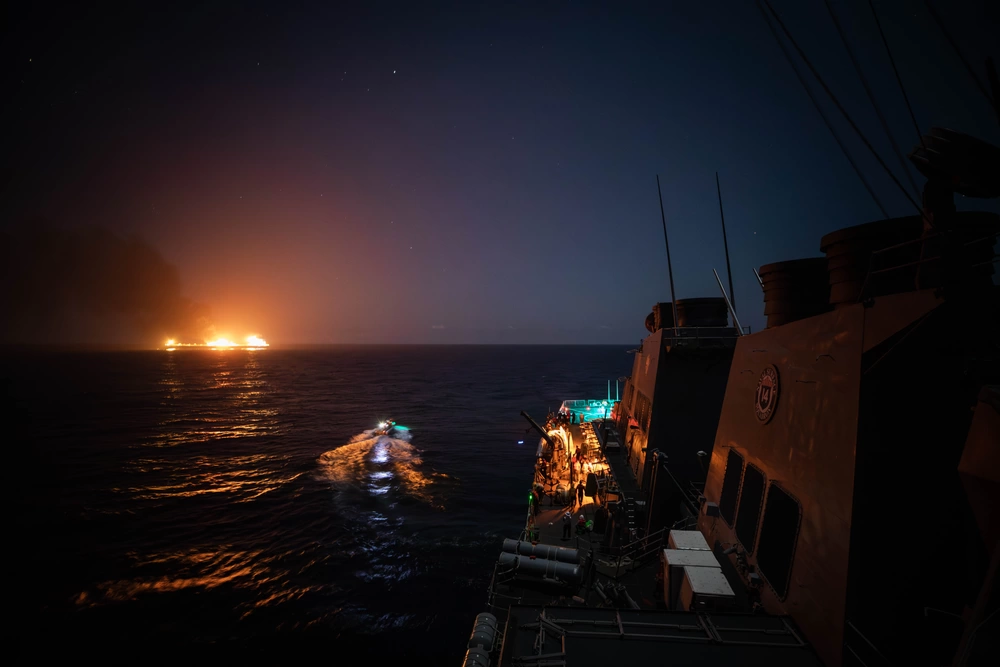
The October 7th, 2023, attacks by Hamas in Southern Israel have reignited open warfare in the world’s most infamous land dispute. The Palestinian cause has seen direct support from the Houthis, a Yemeni armed group jeopardizing global trade and security, threatening to spark an all-out conflict between regional powers. Where Israel-aligned states risk Houthi attacks and seizure of commercial and military ships, Houthi operations are ratcheting up security tensions between Iran and Saudi Arabia as they grapple for regional influence.
Houthi drone and missile attacks, as well as their seizure of commercial ships registered in Israeli-aligned countries, have menaced 12-15% of worldwide maritime trade through the Red Sea, an artery of global trade that links Europe to the Indian Ocean through Egypt’s Suez Canal. The group’s operations threaten supply chain integrity for Western trade with China and India, as well as massive trade and development strategies such as China’s Belt and Road Initiative.
Yemen’s Houthis: Who Are They?
Under the slogan “God is Greatest, Death to America, Death to Israel, Curse the Jews and Victory to Islam”, the Houthis hope to rule Yemen with protection for its hitherto-marginalized Zaydi Shia minority, promote economic development and anti-corruption, end foreign interference and bring about the dismantling of the Israeli state. Their leader, Abdul Malik al-Houthi, has vowed to “escalate more and more if the barbaric and brutal aggression against Gaza does not stop, along with the siege of the Palestinian people from whom they deny aid and medicine.”
Since mid-November, shipping firms are now opting for the far longer route around southern Africa, substantially compounding worldwide trade costs in a conflict that may soon show major economic ripple effects. By March 2, the group had sunk its first international ship, the UK-owned, Lebanese-operated Rubymar, and killed three sailors on the Liberian-owned True Confidence in a March 6 missile attack.
The U.S. and U.K. have responded in kind with tit-for-tat airstrikes and anti-drone operations since January 11th. Joe Biden has quoted these attacks as a “direct response” to the attacks on ships, attacks that “jeopardized trade, and threatened freedom of navigation”. British PM Rishi Sunak underlined this action as “necessary and proportionate” to guard shipping.
Yemen and the Saudi-Iranian “New Arab Cold War”
On a regional scale, the Houthis have substantially benefited from Iran’s Islamic Revolutionary Guard Corps (IRGC) supplying major aid shipments and aerial warfare capabilities as early as the late 2000s They began waging a civil war against the internationally recognized Yemeni government in 2014, and the Saudi-led military coalition set up against the Houthis has since seen widespread allegations of war crimes. Their power base in northern Yemen along the Saudi border, the group remains a perfect candidate for regional security disruption that Iran hopes will bog down Saudi efforts and steer resources from more contentious battlegrounds in Iraq and Syria, both of whom boast substantial Shia minorities.
While many commentators have identified Saudi/Iranian feuding as great power competition in the “New Arab Cold War”, it is limited neither to a single national arena nor conflict. Indeed, Saudi support for rebel groups fighting the Iranian-backed al-Assad regime in Syria, as well as Saudi support for the incumbent Lebanese government against the pro-Iranian Hezbollah organization, broaden the conflict’s regional scope beyond Yemen itself. Backing powerful military actors that can be trusted to oppose Saudi hegemony, Iran remains hard at work enriching uranium stockpiles for a nuclear weapon—an ominous prospect looming since the Trump-led U.S. exit from the JCPOA in 2021—and developing longer-range and more accurate missiles literally extending the shadow of its power further over the world.
All of the above threaten Saudi Arabia’s place at peace talks looking to end the Yemeni Civil War, a truce ongoing since April 2022. With some fearing that international action against Houthi attacks will complicate the peace process, Iran sees its ideal in complicating a long, difficult process that will divert Saudi attention from elsewhere in the region. Whereas Saudi Arabia constitutes an immediate regional threat to Houthi’s success, the group ultimately hopes to impede American influence and, with it, their ability to fund Saudi military influence across the Arab World. Russia and China, while having voiced disapproval of anti-Houthi strikes at the UN Security Council, stand to gain little from their warmer respective relations with Iran over this issue—both states enjoy cheap Iranian oil passing through the Red Sea corridor, and would suffer from Suez Canal closures this may provoke.
A United International Front
Whatever the present division over what constitutes “proportionate and legal action” in response to Houthi aggression against maritime trade and regional security, a united international front is still apparent, supported by UNSC Resolution 2722 that demands the attacks halt. This disagreement shared between UNSC members – the U.S./U.K. and Russia/China – may well complicate further multilateral action against the Houthis, thus isolating the U.S. and U.K joint efforts on their own without major cooperation on both sides of Red Sea supply chains.
With a death toll in Gaza allegedly creeping into the mid-30,000s and Israeli military command still contemplating its offensive in the southern city of Rafah—the situation deteriorates by the day. By sea, Houthi strikes continue threatening maritime trade and international military presence. A Security Council deadlocked by Russian and Chinese dissent leaves international cooperation moot within the influential organ, leaving U.S./U.K. collaboration out of frame. Finally, as for the Houthis, they press on—an international flashpoint burning brighter by the day.
Edited by Killian Magdelaine
The opinions expressed in this article are solely those of the author and they do not reflect the position of the McGill Journal of Political Studies or the Political Science Students’ Association.
Featured image by US Marine.